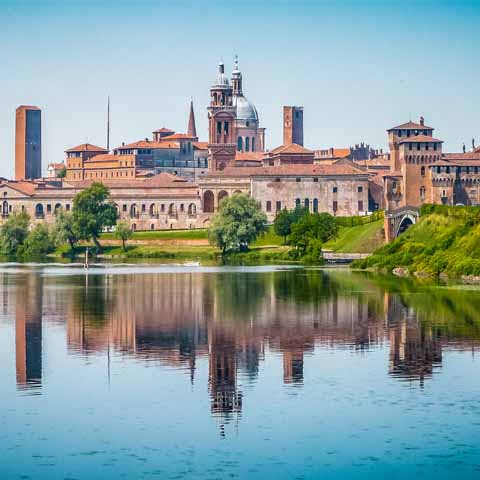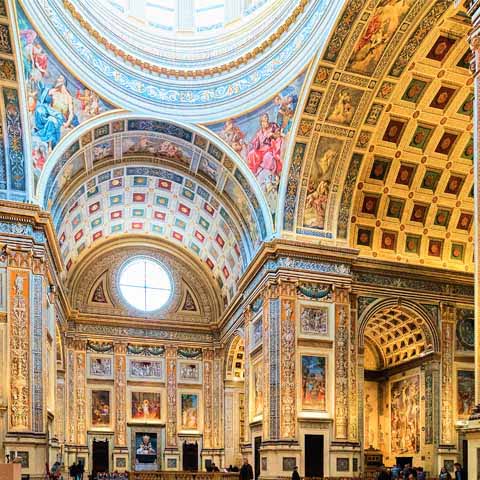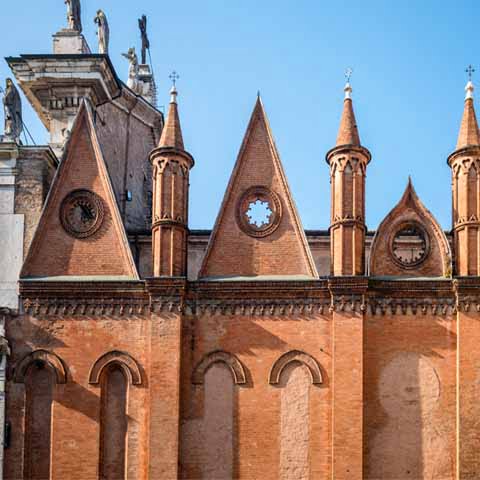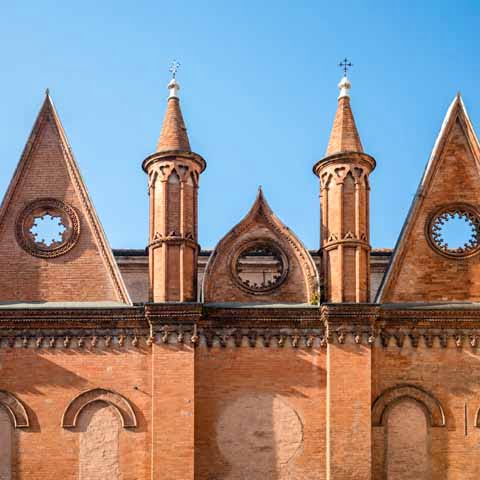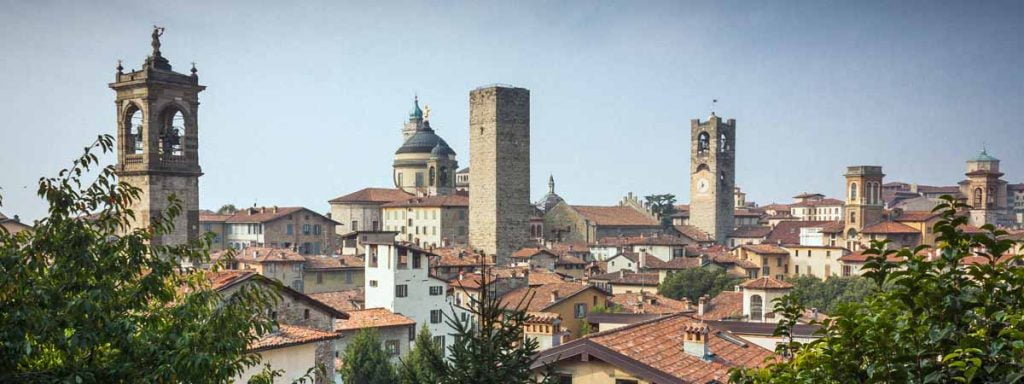Mantua is an Italian city located in the region of Lombardy in Northern Italy. It is the capital city of the province of the same name.
Once an important port destination due to its easy access to the Po River, Mantua is now a bustling art city, home to a wide array of important architecture, art, and cuisine. Often overlooked due to its somewhat somber appearance and humid, foggy weather, it is actually a treasure trove of wonderful sightseeing, artistic inspiration, and rich culture.
Around 50,000 inhabitants live there, and it is considered to be among the best cities in Italy in terms of quality of life and the environment. Its economy is based primarily in processing and shipping, particularly agricultural products. This is due to the lakes which surround the city, offering easy transportation to major rivers.
The old portion of Mantua, known as centro storico, or historic center, was declared, along with the nearby city of Sabbioneta, a UNESCO World Heritage Site in 2006. Sabbioneta is a truly unique Medieval city that is surrounded by walls and home to centuries of history. Together with Sabbioneta, Mantua’s inclusion in this designation by UNESCO is truly indicative of the rich, cultural and historical significance that the city holds.
The first human settlements documented in Mantua date to Neolithic times, and there is evidence of settlements there all throughout to Gallic times. During Roman times, the city gained fame, as it was the birthplace of the poet Virgil. The city grew politically and financially due to its ideal location on the water, charging tolls for those who needed to pass through to get to the Po River.
The city’s best centuries were when the Gonzaga family ruled. This occurred from the early 1300s to the early 1700s. The House of Gonzaga was known for deep appreciation of the arts, and as a result some of the best artists of the Italian Renaissance, including Pisanello and Mantegna spent time in Mantua creating artwork for the Gonzaga Court. It was also during their rule that the majority of Mantua’s greatest monuments and architectural sites where constructed. During Gonzaga rule, the city grew culturally, architecturally, and artistically, becoming a place of inspiration and creativity for artists, writers, musicians, and more. Furthermore, at the height of power for the House of Gonzaga, the city was recognized as one of Northern Italy’s most important cultural and musical hubs.
Today, evidence of these centuries of art can be found throughout Mantua’s elegant palaces, famed theater, historic monuments, and array of important architecture in its old structures and churches.well-known walking path known as Via dell’Amore, or “Street of Love.” The romantic trail runs along the coastline between Riomaggiore and Manarola. Though this particular path closed for renovations following a 2012 landslide, it is scheduled to reopen in 2023.
GEOGRAPHY & CLIMATE
Located in the southeast portion of the Lombardy region in Northern Italy, Mantua is characterized by its landscape. Three lakes – Lago Superiore, Lago di Mezzo, and Lago Inferiore – surround the city. They are all man-made, as they were created in the twelfth century as a defense for the city. The surrounding area of Mantua also features hills to the north and plains to the south.
Mantua’s climate is temperate, verging on warm. Throughout the year, visitors can expect a significant amount of rain and moisture and an average temperature of about 60°F.
ONLY IN MANTUA
While the Cinque Terre are small in area, must-see sites abound for visitors of all ages. From the stunning footpaths and coastal views to the timeless architecture and village squares, there are many aspects of these secluded Italian gems that lure travelers to the area for the majority of the year.
A historical element present in each of the villages would be the well-preserved churches dating as far back as the 13th century. A majority of the churches still standing today have a gothic style to them with facades featuring marble, rose windows, and plenty of symbolism. Churches that should not be missed include the Church of San Giovanni Battista (Riomaggiore), the Church of San Pietro (Corniglia), the Church of Santa Margarita di Aniochia (Vernazza), and the Church of San Giovanni Battista (Monterosso).
The numerous ancient footpaths throughout Cinque Terre are a draw for many visitors. With other means of travel at a minimum, the trails not only provide access to each village, they also offer spectacular views of the majestic coast and colorful architecture.
Each village prides itself on a sanctuary walk that leads to ancient religious havens located on the elevated cliffs. Historically utilized for Catholic penance, they now offer opportunities for scenic views of the villages and sea below. Although accessible by car, these sanctuary walks are most enjoyable on foot for a step back in history, full immersion in the spirituality and culture, and a deep appreciation of each village’s natural beauty. The sanctuary jewels in each municipality are the Nostra Signora della Salute Sanctuary in Manarola; the Nostra Signora delle Grazie in Corniglia; the Nostra Signora di Montenero Sanctuary in Riomaggiore; the Nostra Signora di Reggio in Vernazza; and the Nostra Signora di Soviore in Monterosso al Mare.
The romantic Via dell’Amore is one section of the larger Sentiero Azzurro, or Blue Trail, which is 7.5 miles long and connects all of the Cinque Terre villages. The path is favored among visitors because it is fairly easy with mostly flat terrain and it offers plenty of stunning panoramic views. The Sentiero del Crinale n. 1 or Sentiero Rosso, Ridge Trail #1 or Red Trail, is well known among the more experienced. Extending from Portovenere to Levanto and sweeping over the five villages, this former mule track is nearly 25 miles in length. Following the coastal ridge, the full path can take up to 12 hours to traverse from start to finish. Due to its length, the path is best approached in portions with many taking advantage of the rest stops located along the path.
The village of Monterosso is home to the statue Il Gigante, or The Giant. This 45-foot-tall sculpture of Neptune, the god of the sea was constructed in 1910 by two men – Arrigo Menerbi, a sculptor and Francesco Levacher, an architect. The immense concrete depiction is located between the village’s harbor and Fegina beach next to the terrace of a historic villa. Though bombing during World War II and decades of rough seas have greatly damaged the imposing statue, it continues to stand as one of Monterosso’s
Explore the stunning palaces for which the city is so well known for. The grandest of them all is Palazzo Ducale. For three centuries it served as the home of the Gonzaga family, the rulers of Mantua during its glory days and one of Italy’s most powerful historic families. It covers a mammoth 35,000 square feet, complete with 500 rooms and countless courtyards, gardens, and artworks. One of the most breathtaking aspects of the palace is the famed Camera degli Sposi, which is richly decorated with frescoes by Renaissance painter Andrea Mantegna.
There is also the Palazzo Te, home to floor to ceiling frescoes and numerous splendidly decorated rooms. The stately palace dates back to the sixteenth century and is renowned for its mannerist architecture. The grounds feature a vast park area, perfect for a relaxing afternoon surrounded by nature. Other palaces include the fourteenth century Palazzo del Capitano, thirteenth century Palazzo della Ragione, and thirteenth century Palazzo del Podestà.
Dine on the city’s delicious cuisine. Having earned the title of “European Capital of Gastronomy” in 2017, Mantua’s culture is deeply rooted in food and wine. Its unique cuisine is characterized by simple, local ingredients prepared in a luxurious way. The bars, restaurants, and cafés located throughout Mantua are the perfect way for travelers to experience local traditional foods such as pumpkin ravioli (made with the area’s staple zucca mantovana, or Mantuan pumpkin), donkey stew, sbrisolona cake, and Lambrusco wine.
Experience the spiritual history of the city by visiting some of local churches. The fourteenth century Basilica of Sant’Andrea is the most famous, as it holds Earth that was said to have been soaked by the blood of Christ during his crucifixion. The basilica also features artwork by Andrea Mantegna, while the cupola was designed by Filippo Juvarra. Other churches worth seeing are the Romanesque and Gothic style Cathedral of San Pietro and the ancient Rotonda di San Lorenzo, which dates back to the eleventh century and is decorated with Byzantine frescoes.
When in Mantua, consider visiting the nearby town of Sabbioneta, surrounded by fascinating Medieval walls. Though small, this town holds such a vast amount of history that it earned a spot on the UNESCO list of World Heritage Sites.
Thanks to its rich past under the rule of the House of Gonzaga, Mantua offers a mesmerizing array of notable art and architecture. For the perfect trip, be sure to sample some of the city’s delicious food and wine while exploring the UNESCO-recognized historic city center.
The Cinque Terre area of Liguria is one of Northern Italy’s most popular destinations, winning the hearts of visitors with its extraordinary charm, rich history, natural beauty, and exquisite art and architecture. The discovery of Cinque Terre’s soul is an astounding journey through time and scenery.
Don't just see Italy, live it.
Your dream trip to Italy has never been closer
No more endlessly scrolling travel sites. Our travel experts will craft the perfect, one-of-a-kind trip just for you.

300+
DESTINATIONS
We offer more Italian destinations than any travel site. Do and see more with Trips 2 Italy.
1 (of a kind)
ITINERARIES
Because your dream trip to Italy should be designed for you, not for the masses.
100%
PEACE OF MIND
From flights and accommodations, to food and activities - we take care of every detail.
